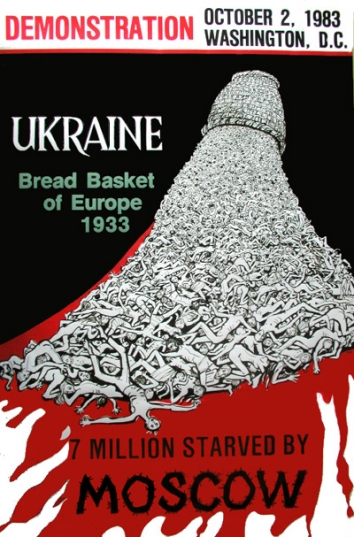Featured Galleries USUBC COLLECTION OF OVER 160 UKRAINE HISTORIC NEWS PHOTOGRAPHS 1918-1997
 Holodomor Posters
Holodomor Posters

Private Equity deal-making continues despite slower overall M&A environment
 Ernst & Young LLC, Kyiv, Ukraine
Ernst & Young LLC, Kyiv, Ukraine
22 March, 2012
- Africa is starting to attract PE investment beyond South Africa’s borders
- Growth in Latin American fund-raising bucks global trend
- Domestic firms drive PE deal activity in China
- Smaller deals drive PE activity in India
- Entrepreneurial spirit is key to PE’s staying power
22 MARCH 2012 – PE-backed M&A exits reached US$20.4b in the first two months of 2012, up nearly 15% from last September and October’s market lows. PE-backed IPOs, while still challenged by tentative capital markets, raised more than US$1.5b in the first two months of this year, up from a low of just US$600 million in September and October 2011[1]. While deal activity remains positive at the start of 2012, overall value was down on the same period last year with US$32.7b in M&A exits and US$7.3b in IPO exits.
According to Global private equity watch – a return to entrepreneurship 2012, an annual study by Ernst & Young, an entrepreneurial mindset has been the key driver to the industry’s ability to adapt to the ongoing volatility.
Jeffrey Bunder, Global Private Equity Leader at Ernst & Young says: “Obtaining debt financing for PE deals was particularly difficult in the second half of 2011. So far this year credit is more readily available for high-quality assets, though this varies by geography, size and sector. PE is demonstrating its ability to sign high-quality deals by using all equity or higher proportions of equity and exploring less obvious sources of debt finance. With weaker demand domestically, European PE investors are tapping the US high-yield bond market to finance deals, for example.”
PE activity in the Americas remained broadly stable through 2011 in terms of deal value, while Asia Pacific region saw a modest increase in value. By contrast, Europe saw a drop-off in activity, largely driven by the European debt crisis.
Bunder continues, “Over the last few years, PE has extended well beyond its traditional markets into fast-growth economies such as India, China and Brazil in an attempt to capitalize on the emerging middle class dynamic in these geographies. In the future though, it is those PE firms with the vision to tap into the world’s so-called “frontier markets” such as, Colombia, Chile, Indonesia, Vietnam Czech Republic, Turkey, will that reap above average returns. These markets share similar trends to the BRIC countries, but valuations tend to be more reasonable and competition more limited.”
Vladyslav Ostapenko, Head of Corporate Finances and M&A in Ukraine:
"Ukraine stays in line with global trend – private equity houses keep their investment activity at high level and actively searching for new deals. Of course the speed of transactions are becoming slower due to uncertainty and expectations of local currency devaluation, but this factors have less influence on businesses which done their homework – prepared robust business plan, supported their valuation by audited financials etc. Our current pipeline of projects and its progress shows that PEs are sustainable source of capital Ukrainian companies can count on."
Africa PE outlook
Sub-Saharan Africa is one of the “frontier markets” with the most potential. In the last few years, Africa, as a whole, has experienced a broad range of reforms, with improvements in infrastructure aimed at regional integration, meaning that the continent is now ready for investments and a number of funds have already established themselves there. GDP growth across Africa is expected to average 5% over the next 10 years, with Ghana, Ethiopia and Uganda, projected to exceed 7% GDP growth per year. But with PE’s penetration in the regions low – just 0.11% in sub-Saharan Africa – there is less competition for deals and investment opportunity.
South Africa remains the region’s largest PE market having attracted the most PE investment over the last two years, but opportunities beyond its borders are starting to attract more interest.
Says Bunder: “The range of deals available to PE investors is also expanding as the region’s economies diversify away from their reliance on extractive industries. Financial services, technology, telecoms, agriculture, consumer products and infrastructure investments all figure prominently in the sectors attractive to PE in Africa today.”
The rise in Latin American fund-raising bucks the global trend
PE activity in Latin America continues to strengthen, with robust fund-raising, steady deal-making, and an improving exit market environment. In contrast to global trends, fund raising for Latin America rose by 68%, from US$8.3b in 2010 (72 deals) to US$13.9b in 2011 (77 deals).
Fund-raising for Latin America defied the sluggish rate of global fund-raising and rose by 68% in 2011 from US$8.3b in 2010 to US$13.9b. Interestingly, local managers accounted for more than 75% of the year’s fund raised during the year. As in past years, the bulk of commitments targeted Brazil.
Deal-making in China continues amid global decline
PE activity in China continues to expand, with growth in PE deal activity supported by an increasing supply of local PE capital and the availability of exit alternatives. Unlike India, where PE deal activity is driven by global firms, China has an increasing number of domestic firms that are competing for PE deals, including 8 of the top 10 PE deals in China Q4 2011.
PE fund-raising in China did decline by 11% from US$32.1b in 2010 to US$28.5b in 2011. The second half of 2011 witnessed new commitments totaling US$8.6b, just half that of the first part of the year. However, LPs and GPs remain focused on Asia Pacific and China in particular as local currency PE funds continue to expand. Renminbi (RMB) funds experienced a 28% year-on-year increase in their aggregate value to US$11.4b in 2011, demonstrating that local investor participation in Chinese PE is on the rise.
Continued long-term interest in Indian PE
Indian PE activity started 2011 on a high note, with deal buoyancy carried forward from late 2010. However, in line with global trends, the second half witnessed a steep decline in investment value, while volume remained consistent throughout 2011. Year-on-year comparison indicates 15% and 20% increase in aggregate deal value and volume, respectively, compared to 2010.
PE-backed IPOs declined in 2011, with just 8 IPOs by PE, significantly down on the 27 seen in 2010. The amount raised also dropped from US$4.3b to US$1.2b – a 71% decline. This is the reflection of the uncertainty last year in Indian stock markets and as a result, PE has delayed listing portfolio companies, but is ready to push the button when market conditions improve.
However, the long-term attraction of the Indian market was demonstrated by the improvement in fund-raising toward the end of the year. In Q4 2011, PE and VC firms launched fund-raising processes targeting an aggregate US$7.5b. Bunder says: “Recently, some firms have abandoned fund-raising specifically targeted toward investments in India, yet the signs are that firms with a proven track record of returning money investors will be successful.”
Entrepreneurial spirit is key to PE’s staying power
Other findings from the report include examples of how PE firms have demonstrated their entrepreneurial ability to respond to severe economic volatility, a consequence of the global recession. Concludes Bunder: “These behaviors were critical to overcoming the economic challenges and enabled value creation on behalf their investors. This entrepreneurial approach is a key element to the industry’s future success.”
About Ernst & Young
Ernst & Young is a global leader in assurance, tax, transaction and advisory services. Worldwide, our 152,000 people are united by our shared values and an unwavering commitment to quality. We make a difference by helping our people, our clients and our wider communities achieve their potential.
Ernst & Young expands its services and resources in accordance with clients’ needs throughout the CIS. 4000 professionals work at 18 offices in Moscow, St. Petersburg, Novosibirsk, Ekaterinburg, Kazan, Krasnodar, Togliatti, Yuzhno-Sakhalinsk, Almaty, Astana, Atyrau, Baku, Kyiv, Donetsk, Tashkent, Tbilisi, Yerevan, and Minsk.
Ernst & Young established its practice in Ukraine in 1991. Ernst & Young Ukraine now employs more than 500 professionals providing a full range of services to a number of multinational corporations and Ukrainian enterprises.
For more information about our organization, please visit www.ey.com/ua.
This news release has been issued by EYGM Limited, a member of the global Ernst & Young organization that also does not provide any services to clients.











